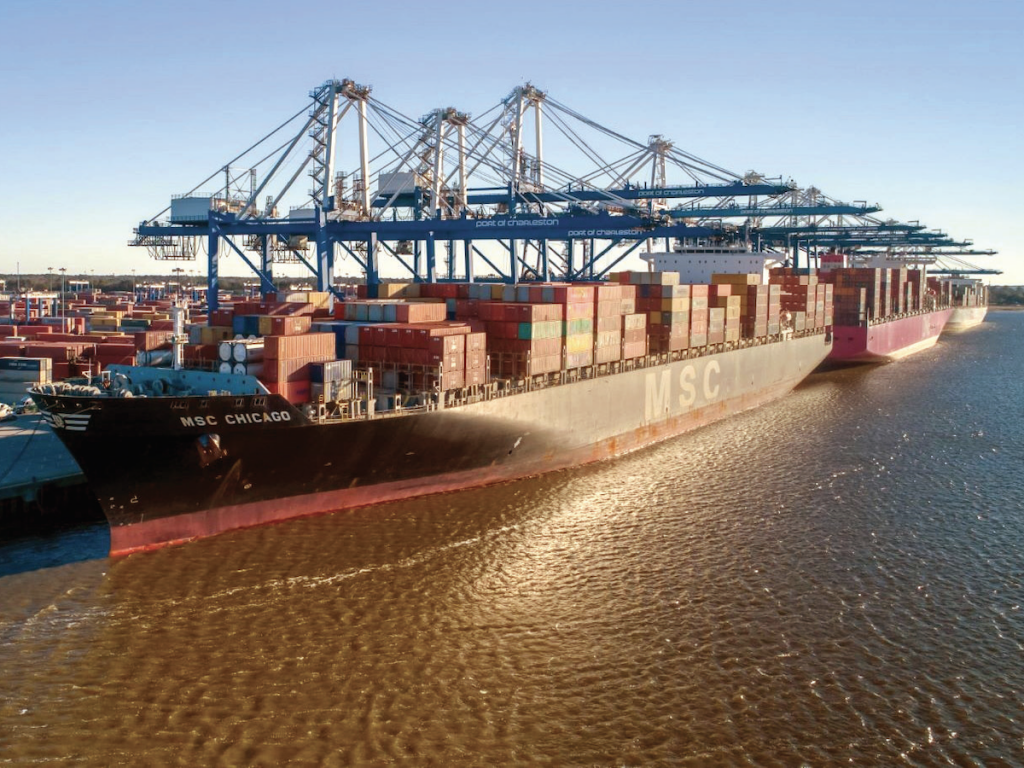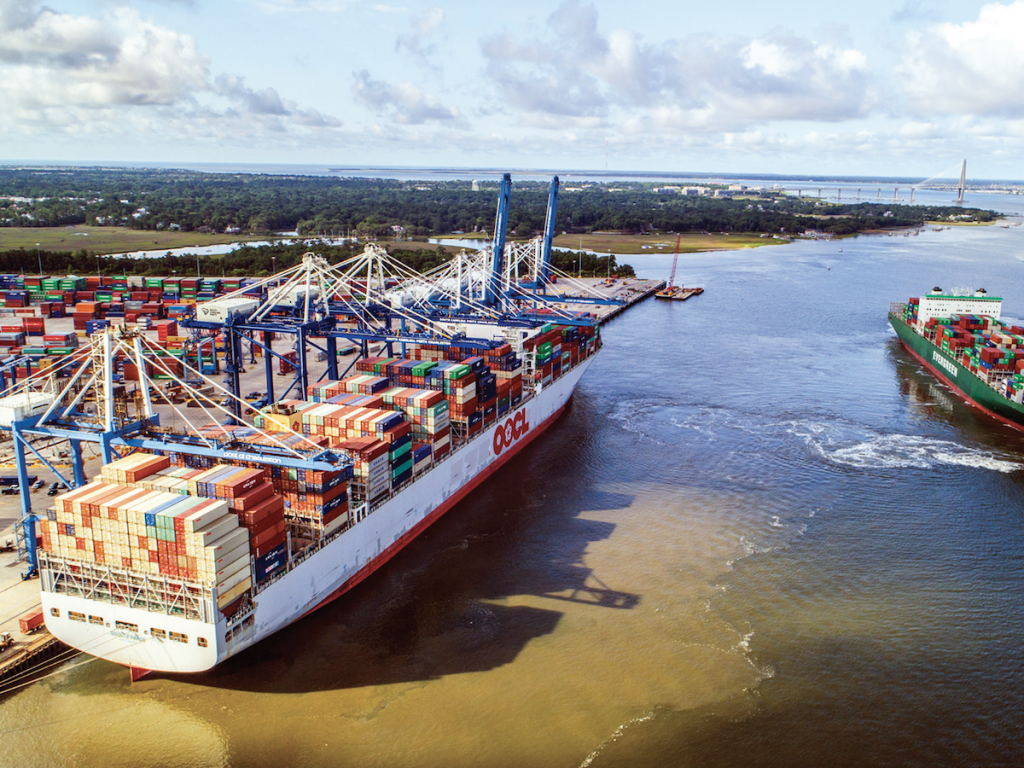As James I. “Jim” Newsome III enters his second decade as head of the South Carolina Ports Authority, the Port of Charleston is prepared to continue unprecedented growth, with new terminal development poised to meet big-containership infrastructure demands for the next half century and beyond.

“Things have gone well and I think will continue to go well.” Newsome unassumingly told AJOT as he marked his 10-year anniversary as SCPA’s president and chief executive officer in September.
“The growth of our port has exactly mirrored the tremendous growth in manufacturing in the state of South Carolina,” Newsome said, citing expansions in the Palmetto State and other Southeast states by such firms as automakers BMW, Volvo and Mercedes-Benz, as well as tire manufacturer Michelin and power tools leader Techtronic Industries Co. Ltd., known for short as TTI.
“I’m very pleased with the progress,” Newsome said. “We’ve doubled our container volume in 10 years. That’s 80 percent of our business, so that’s important.”
In its fiscal year ended June 30, SCPA handled nearly 2.4 million 20-foot-equivalent units of containerized cargo, up 8.8 percent from the immediately preceding 12-month period. And SCPA is getting its current fiscal year off to a dynamic start, moving 210,542 TEUs in July, its busiest month ever until besting that mark in August by handling 233,110 TEUs.
“We’re about 20,000 containers ahead of our plan,” Newsome said in referring to the first two months of the current fiscal year. “It’s important to stay ahead of your plan, particularly now with some creeping uncertainties about the economy.”
The impressive TEU figures for SCPA’s Wando Welch and North Charleston container terminals only tell part of the success story.

Over the past decade, SCPA has added more than $1 billion in assets to its balance sheet, upgrading and enhancing marine terminal and rail infrastructure, including bringing two inland ports online and putting in place its RapidRail link. Charleston now moves 24 percent of its container volume via rail, which, according to Newsome, is “exceptional for a Southeast port.”
Furthermore, SCPA has, in addition to vastly modernizing the Port of Charleston’s venerable Wando Welch Terminal and moving channel deepening toward completion, embarked upon development of what bodes to be the first all-new container terminal on the U.S. East or Gulf coasts since the 2009 opening of the Jacksonville Port Authority’s TraPac facility in Northeast Florida.
Maritime shipping’s continuing shift to larger containerships operated by ocean carrier consortia has been a primary force behind much of the development. Low-sulfur fuel requirements should accelerate that trend.
“It’s something I’m extremely proud of,” Newsome said of Wando Welch Terminal expansion. “What we’ve done there is pretty remarkable.”
By the end of 2020, SCPA will have invested $450 million at Wando Welch, bringing online 15 tall cranes, each with 155 feet of lift height, to facilitate simultaneous accommodation of three 14,000-TEU-capacity ships – or even an 18,000-TEU megavessel – and increased annual throughput capacity at the terminal by 700,000 TEUs, to 2.4 million TEUs. Addition of two-dozen more rubber-tired gantry cranes looks to bring the total of such units to 65.
“We think we’ll see an 18,000-TEU ship on the East Coast in a year or two,” Newsome said, “and we want to be ready for that. We think the ability to handle multiple big ships is key to the future.
“We really are focused on making sure that our terminals continue to work exceptionally well,” Newsome said, noting that ship-to-shore cranes are accomplishing better than 35 moves per hour. Truck turns, including queue time, are typically well within an hour.
SCPA has 12 cranes on order from Shanghai Zhenhua Heavy Industries Co. Ltd. (ZPMC) – seven for the Wando Welch facility and five, each with 169-foot lift height, for the Hugh K. Leatherman Sr. Terminal that is springing up on the site of a former U.S. Navy base.
The Leatherman Terminal’s initial single-berth phase, with 700,000 TEUs of annual throughput capacity, is on target to open in March 2021. By 2032, the new terminal is to be built out to full capacity of 2.4 million TEUs a year – similar to that of the expanded Wando Welch Terminal.
“I think we’ve done everything just in the right time,” Newsome said.
Timing of the deepening of Charleston Harbor to 52 feet has been spot-on as well, with deepening as far as Wando Welch and Leatherman terminals anticipated to be done by the early 2021 opening of the first Leatherman berth. Also, the Wando Welch turning basin is being widened to 1,650 feet from its present 1,450 feet.
“We will have completed a deep-draft navigation project from start to finish in a little over 10 years, which is pretty amazing,” Newsome said. “I think people will look back on it as kind of a textbook case of how to do a dredging project, and, I think equally what I can say with absolute certainty is that we’ll never deepen this harbor again.”
The 52-foot depth should allow the Port of Charleston to handle ships with 48-foot draft without tidal restrictions.
“That’s essentially a fully loaded 8,000-TEU containership or a very heavily loaded 14,000-TEU containership,” Newsome said. “As exports continue to grow, assuming they do, draft becomes more and more of an issue, because the exports are heavy.”
On the rail infrastructure front, SCPA last year opened the CSX-served Inland Port Dillon just off Interstate 95 near the South Carolina-North Carolina line, about 130 miles north-northeast of Charleston, with California-based Harbor Freight Tools as anchor client.
The Dillon installation has followed the 2013 opening of SCPA’s first inland facility, a Norfolk Southern-served facility in Greer, along Interstate 85, about 220 miles northwest of Charleston, with the only sure promise being 25,000 containers a year for BMW’s nearby assembly plant.
“Greer has been exceptionally successful,” said Newsome, citing the more than 140,000 rail lifts at Inland Port Greer in the last fiscal year. “I will tell you with pride that we had about 10 target clients, and I think about every one of them uses that facility today.
“We’re looking at a textbook case of how short-haul rail in the South can be successful.” Newsome said. “It gave us the confidence to open Dillon here more recently. To have this type of short-haul rail infrastructure is a significant enhancement to what the port is in and of itself providing. So I think we’re in a good situation.”
Making the situation even more promising on a long-term basis is the collaboration with longtime competitor Georgia Ports Authority on development of a 1,500-acre terminal with annual throughput capacity of a whopping 7 million TEUs in South Carolina’s Jasper County near the head of the Savannah River. Combined public and private investment could reach $7 billion, according to Newsome.

“It would be the biggest single terminal in the United States in one footprint,” Newsome said. “We’re working on it now, but it’s futuristic. You have to start working on it now in the pre-permitting phase, doing the studies that are needed to get ready to launch a permitting effort one day.”
Jasper Ocean Terminal’s first phase is targeted for completion somewhere between 2035 to 2037 timeframe. Lots of work remains to be done at the currently undeveloped site, including bringing in both CSX and Norfolk Southern rail.
“There are a lot more questions than answers,” Newsome said, “but it’s an exciting prospect, because what it does say is that, with that terminal, you’ll be able to answer the question of whether you have enough infrastructure for the next 50 or 60 years.
“Is it hard for two ports that have always competed staunchly to work together on such a project? Yes, it’s probably not easy,” Newsome continued. “But I think we can do it. I think the need to address port infrastructure in the region will take precedence over any hard feelings over competition or whatever.”
Meanwhile, SCPA is beefing up retail distribution offerings. TradePort Logistics, which handles cargo for such mega-retailers as Walmart, has recently moved into a 200,000-square-foot warehouse at the Wando Welch Terminal, with expectations of initially handling 20,000 import containers on an annual basis. Also, SCPA has purchased a 1,000-acre site near Ridgeville, about 40 miles northwest of Charleston along Interstate 26, for future private development of distribution centers.
All of this success – including as cited in a new study by the University of South Carolina’s Darla Moore School of Business placing SCPA’s annual economic impacts at $62 billion a year, up from $53 billion in 2015 – hasn’t gone to Newsome’s head.
“What really makes this place work is the people of the port.” said Newsome, including 700 people directly working for the port authority (200 more than a decade ago) plus International Longshoremen’s Association labor, tugboat operators, harbor pilots, truck drivers, warehouse workers and others instrumental in growing Charleston’s cargo base. “We just have a really good maritime community here.”





